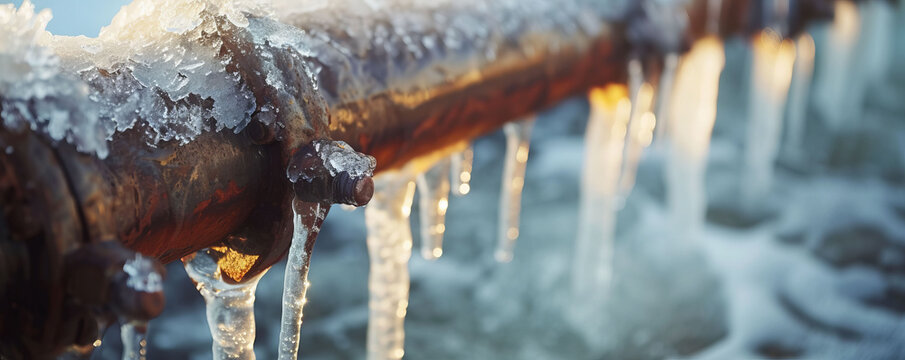Safeguarding Your Pipes from Freezing Issues: Critical Strategies
Safeguarding Your Pipes from Freezing Issues: Critical Strategies
Blog Article
This post in the next paragraphs relating to How to prepare your home plumbing for winter weather is really interesting. You should investigate for yourself.

Winter can damage your plumbing, particularly by freezing pipes. Below's exactly how to avoid it from occurring and what to do if it does.
Intro
As temperature levels decrease, the risk of frozen pipelines boosts, potentially resulting in expensive fixings and water damages. Comprehending exactly how to stop icy pipelines is critical for property owners in cool climates.
Avoidance Tips
Shielding at risk pipes
Cover pipelines in insulation sleeves or use warmth tape to safeguard them from freezing temperature levels. Focus on pipes in unheated or external areas of the home.
Heating strategies
Keep indoor spaces appropriately heated, specifically locations with plumbing. Open up cupboard doors to enable cozy air to flow around pipelines under sinks.
Exactly how to identify icy pipes
Look for decreased water circulation from faucets, uncommon odors or sounds from pipelines, and visible frost on subjected pipelines.
Long-Term Solutions
Architectural adjustments
Think about rerouting pipelines far from outside walls or unheated areas. Add added insulation to attic rooms, basements, and crawl spaces.
Upgrading insulation
Invest in top notch insulation for pipelines, attic rooms, and walls. Appropriate insulation assists maintain consistent temperatures and reduces the risk of icy pipelines.
Protecting Outdoor Plumbing
Yard hoses and exterior taps
Disconnect and drain garden hoses before winter season. Install frost-proof faucets or cover exterior faucets with insulated caps.
Comprehending Icy Pipelines
What creates pipelines to ice up?
Pipelines ice up when revealed to temperature levels listed below 32 ° F (0 ° C) for expanded durations. As water inside the pipelines freezes, it expands, putting pressure on the pipeline wall surfaces and possibly triggering them to rupture.
Threats and problems
Frozen pipes can lead to water supply disruptions, property damage, and pricey repair work. Burst pipes can flooding homes and create substantial architectural damages.
Indicators of Frozen Piping
Identifying icy pipelines early can prevent them from rupturing.
What to Do If Your Pipes Freeze
Immediate activities to take
If you suspect frozen pipelines, maintain faucets open to alleviate pressure as the ice thaws. Make use of a hairdryer or towels taken in hot water to thaw pipes gradually.
Final thought
Stopping frozen pipelines calls for positive measures and fast actions. By comprehending the reasons, indications, and preventive measures, house owners can secure their pipes throughout cold weather.
Helpful Tips to Prevent Frozen Pipes this Winter
UNDERSTANDING THE BASICS: WHY PIPES FREEZE AND WHY IT’S A PROBLEM
Water freezing inside pipes is common during the winter months, but understanding why pipes freeze, and the potential problems it can cause is crucial in preventing such incidents. This section will delve into the basics of why pipes freeze and the associated problems that may arise.
THE SCIENCE BEHIND FROZEN PIPES
When water reaches freezing temperatures, it undergoes a physical transformation and solidifies into ice. This expansion of water as it freezes is the primary reason pipes can burst. As the water inside the pipe freezes, it expands, creating immense pressure on the walls. If the pressure becomes too great, the pipe can crack or rupture, leading to leaks and water damage.
FACTORS THAT CONTRIBUTE TO PIPE FREEZING
Low Temperatures: Extremely cold weather, especially below freezing, increases the risk of pipes freezing. Uninsulated or Poorly Insulated Pipes: Pipes located in unheated areas, such as basements, crawl spaces, or attics, are more prone to freezing. Insufficient insulation or lack of insulation altogether exacerbates the problem. Exterior Wall Exposure: Pipes running along exterior walls are susceptible to freezing as they encounter colder temperatures outside. Lack of Heating or Temperature Regulation: Inadequate heating or inconsistent temperature control in your home can contribute to frozen pipes. PROBLEMS CAUSED BY FROZEN PIPES
- Pipe Bursting: As mentioned earlier, the expansion of water as it freezes can cause pipes to burst, resulting in significant water damage.
- Water Damage: When pipes burst, it can lead to flooding and water damage to your property, including walls, ceilings, flooring, and personal belongings.
- Structural Damage: Prolonged exposure to water from burst pipes can compromise the structural integrity of your home, leading to costly repairs.
- Mold and Mildew Growth: Excess moisture from water damage can create a favorable environment for mold and mildew growth, posing health risks to occupants.
- Disrupted Water Supply: Frozen pipes can also result in a complete or partial loss of water supply until the issue is resolved.
WHY CERTAIN PIPES ARE MORE PRONE TO FREEZING
- Location: Pipes located in unheated or poorly insulated areas, such as basements, crawl spaces, attics, or exterior walls, are at higher risk of freezing.
- Exterior Pipes: Outdoor pipes, such as those used for irrigation or exposed plumbing, are particularly vulnerable to freezing as they are directly exposed to the elements.
- Supply Lines: Pipes that carry water from the main water supply into your home, including the main water line, are critical to protect as freezing in these lines can affect your entire plumbing system.
- Underground Pipes: Pipes buried underground, such as those connected to sprinkler systems or outdoor faucets, can be susceptible to freezing if not properly insulated.
https://busybusy.com/blog/helpful-tips-to-prevent-frozen-pipes-this-winter/

Do you like more info about 6 Ways to Prevent Frozen Pipes? Try leaving a comment directly below. We'd be happy to know your feelings about this blog. In hopes that you visit us again before long. Do you know about someone else who is interested in the topic? Why not share it. I treasure your readership.
Details Here Report this page